
Apple (NASDAQ:AAPL) has been a bits-and-pieces player in India ever since it entered that market with the iPhone 3G in 2008, but the company’s fortunes started changing in 2020.
A third-party report points out that Apple doubled its market share in India’s smartphone space to 4% in Q4 2020 with shipments of more than 1.5 million units. Apple achieved this feat during a difficult time, as the novel coronavirus pandemic sent millions into poverty in India last year. Jobs were cut and salaries were slashed, but sales of Apple’s iPhones doubled in the final quarter of the year thanks to a wide selection of phones that were offered at different price points suiting different budgets.
This paves the way for Apple to switch into a higher gear in India in 2021 and increase its presence in that market. Let’s see how that may happen.
Apple’s new formula for success in India
Apple has been producing iPhones in India since 2017, but the company has usually stuck to manufacturing older models. It took a step forward in July 2020 when it started making the iPhone 11, its flagship phone at that time, locally. That move helped Apple bring down the price of the iPhone 11 substantially in that market, as it was able to save on taxes and duties, and the result was a solid spike in sales in the final quarter of the year.
Apple is following a similar playbook this year. The company recently announced that it is going to manufacture the iPhone 12 locally in India. This development comes less than six months after the launch of the company’s latest iPhone lineup, which is a big improvement over last year, as the iPhone 11 went into local production in India only toward the end of its life cycle.
This is not surprising. Apple has reportedly been working on shoring up its production facilities in India over the past year in the wake of the pandemic to take advantage of the government’s incentive schemes. Foxconn, Pegatron, and Wistron — three of Apple’s contract manufacturers — have pledged to invest a total of $900 million to make iPhones in India.
This being the case, Apple can be expected to quickly start the local production of its flagship devices in India after their global launch, beginning with the iPhone 12. This would go a long way toward helping the company reduce prices and attract more users into its fold.
For instance, the iPhone 12 currently starts at 79,900 Indian rupees (roughly $1,100 at the current exchange rate). That’s a steep premium over the price at which it is sold in the U.S. But local manufacturing of the device could help Apple save 22% in customs duties and 18% in goods and services tax.
Of course, Apple would still have to pay import duties in the range of 10% to 15% on components that it doesn’t produce locally in India. But it should still be able to achieve nice cost savings, as the company won’t have to pay the huge customs duty it has to incur when importing a completely built unit from abroad. And once Apple passes on the cost savings to customers, the iPhone 12 could become more affordable in India and drive greater volumes.
Setting up for long-term success
Apple reportedly shipped 3.1 million iPhones in India last year, according to Counterpoint Research. The firm expects the company to record double-digit-percentage shipment growth in 2021 and finish the year with 3.5 million shipments, though a higher number could be in the cards depending on how much cost benefit Apple decides to pass on to its customers.
Apple will be doing itself a big favor if it decides to pass on to Indian consumers a big chunk of its cost savings arising out of local production. That’s because India is the world’s second-largest smartphone market, and it still has a lot of room to expand. Newzoo estimates that smartphone penetration in India stands at less than 32%. What’s more, the country has yet to see the deployment of 5G wireless networks.
In all, Apple can set itself up for long-term success in India by making its devices more affordable by way of local production and become a bigger player in this key smartphone market that still offers lucrative growth opportunities.
























